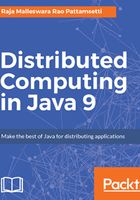
What this book covers
Chapter 1, Quick Start to Distributed Computing, reviews the basic concepts of distributed and parallel computing, what it is, why it is required, and how Java supports distributed computing, along with their architecture.
Chapter 2, Communication between Distributed Applications, covers different ways of communicating with remote systems in a distributed architecture, the concept of sockets, and stream programming with examples and URL-based communication.
Chapter 3, RMI, CORBA, and JavaSpace, teaches what the components of message-based systems are and how architectures such as RMI, CORBA, and Java Spaces complement it.
Chapter 4, Enterprise Messaging, explores the concept of enterprise integration patterns and the concepts of synchronous and asynchronous messaging, with technologies such as JMS and web services.
Chapter 5, HPC Cluster Computing, covers handling large amounts of data through parallel or distributed computing using HPC, cluster-computing architecture, and Java support for these implementations.
Chapter 6, Distributed Databases, covers the concepts and ways to set up a distributed database. It also explains how distributed databases help in performance improvisation with distributed transactions and XA transactions with examples.
Chapter 7, Cloud and Distributed Computing, explains how cloud and distributed computing go hand in hand. You will also learn the setup and procedure to configure your applications on market-leading cloud environments.
Chapter 8, Big Data Analytics, discusses big data concepts and how big data helps in distributed computing. The chapter covers the implementations of big data, along with methods and applications, including Hadoop, MapReduce, and HDFS.
Chapter 9, Testing, Debugging, and Troubleshooting, explores how to test, debug, and troubleshoot distributed systems, and the different challenges in distributed computing.
Chapter 10, Security, discusses different security issues and constraints associated with distributed computing and how to address them.